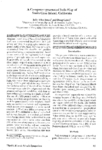- DSpace Home
- →
- Channel Islands
- →
- National Park Service
- →
- California Islands Symposia Documents
- →
- 3rd California Islands Symposium
JavaScript is disabled for your browser. Some features of this site may not work without it.
| dc.contributor.author | Jones, Julia Allen | en |
| dc.contributor.author | Grice, Doug | en |
| dc.date.accessioned | 2011-02-11T23:19:29Z | en |
| dc.date.available | 2011-02-11T23:19:29Z | en |
| dc.date.issued | 1993 | en |
| dc.identifier.citation | Jones, Julia Allen and Doug Grice. "A Computer-generated Soils Map of Santa Cruz Island, California." In: 3rd California Islands Symposium. 1987. 45-56. | en |
| dc.identifier.uri | http://hdl.handle.net/10139/3179 | en |
| dc.description.abstract | A soil map of Santa Cruz Island (249 km2) was constructed based on a field soil survey and data in a geographic information system (GIS) of the island. Soil map units were determined from 138 classified soil profiles generalized using a dasymetric approach based on an overlay of the registered GIS image planes of geologic substrate and vegetation. Nearly 60% of the island is covered by the three largest mapped units, representing soils on volcanics and volcaniclastics under grass and oaks, and soils on the Monterey formation under grass. Eleven subgroups of the USDA Soil Taxonomy (Soil Survey Staff 1975) occur in the large area of island volcanics under grass (37% of the island) and soil spatial variability is high, with two or three subgroups occurring in a single 2.25 ha grid cell of the map. However, the southwest corner of the island has the most heterogeneous soils (14 subgroups) and the greatest soil spatial variability, with four or more subgroups occurring in a single grid cell. The use of a GIS permits rapid generalization of map units from sampled points, but the rales used for generalization were simplistic, based only on geologic substrate and vegetation, which in turn were mapped at a coarse spatial resolution (150 m). It is difficult to compare the accuracy of the technique to that of a standard soil survey, because no standard soil survey exists for the island. Soils not identified in map unit names are estimated to cover less than 25% of the area of any map unit. However, the gridded format means that soil unit boundaries are poorly defined and therefore the map has limited field utility. Nevertheless this map provides a broad overview of the nature and distribution of Santa Cruz Island soils while illustrating a method whereby computerized data could be utilized in soil mapping. | en |
| dc.language.iso | en_US | en |
| dc.publisher | National Park Service | en |
| dc.subject | California Islands | en |
| dc.subject | Channel Islands | en |
| dc.subject | Soil mapping using GIS | en |
| dc.title | A Computer-generated Soils Map of Santa Cruz Island, California | en |
| dc.type | Article | en |

